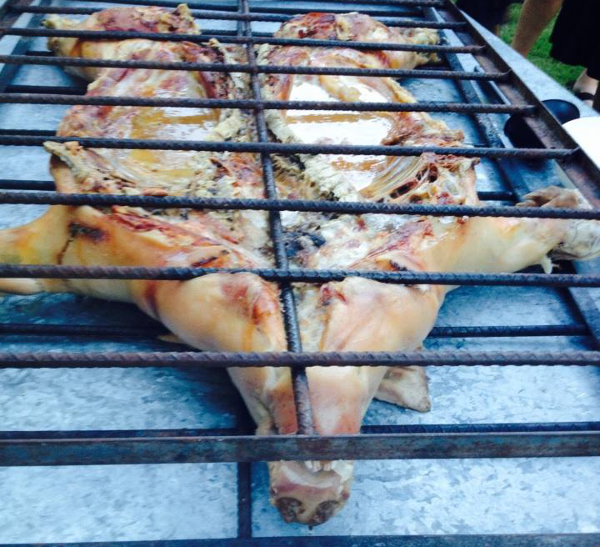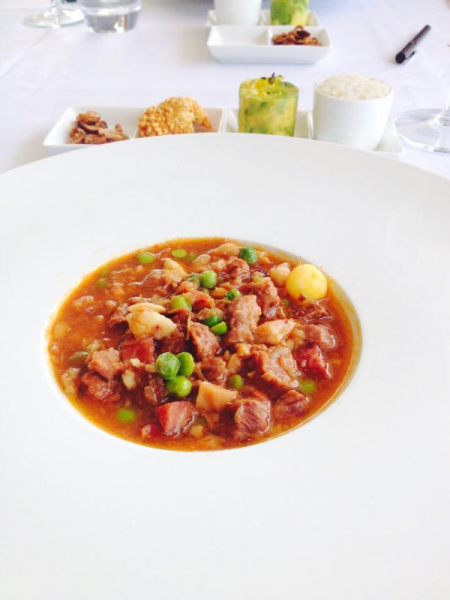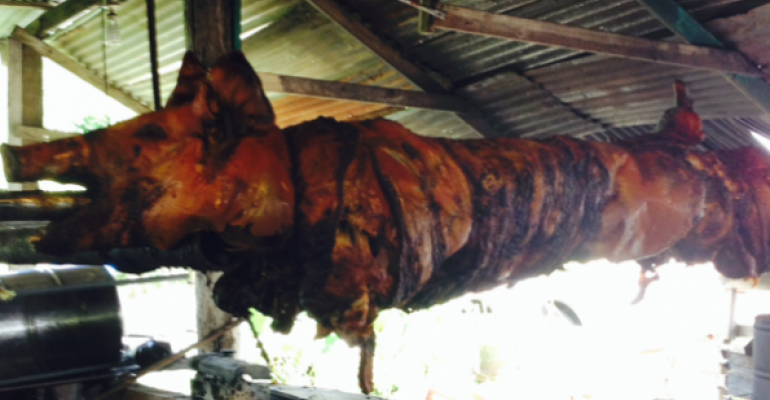I don’t agree with work-life balance.
I mean, I think it can be done, and it might even be desirable for some people, but I doubt you can be at the top of your game if your main focus is on balancing work and play. I doubt Fortune 500 CEOs got their jobs by working 8-hour days and then hanging out with friends and family and making sure they attended every little league game and dance recital.
I brought this up with MUFSO keynoter Jeremy Gutsche, in an alcohol-enhanced conversation the night before his speech, because that’s why you go to MUFSO — to talk to smart people in the food industry about topics of interest, sometimes over alcohol.
He said he agreed with me and that the key to success is loving your work.
And so I didn’t mind working all weekend, with the daunting task of gaining a better understanding of what sort of delicious pork is available in Puerto Rico.
The Pork Crawl is something the National Pork Board does every year. They invite a bunch of editors from foodservice trade publications to a particular community to examine what sorts of things the locals do with the product the pork board is in charge of promoting.
I have to attend the Pork Crawl. It is my job. The fact that it’s a lot of delicious fun, well, if I covered tungsten or printed circuit-board assemblies, I might go on different sorts of field trips, but I chose to write about food, and so I was obligated to catch a 6am flight on Thursday morning, change planes in Orlando and then fly to San Juan, where I was at the pork board’s mercy.
They required me to go with them to a lovely villa at the St. Regis Bahia Beach Resort, where chef Jose Enrique prepared a pig Criolla-style in a caja China (literally "Chinese box;" it's a box in which meats are roasted in much of Latin America).
Here’s a preliminary view of dinner . It actually had a few hours of roasting to go yet, but at this point, delicous broth had pooled in the body cavity of the pig, and we were invited to dip soft fluffy bread in it to sop it up. The only seasoning used for this pig was salt. After chowing down on its crispy skin, we had cocktails and then made probably the best sandwich I’ve ever had with the pork skin and flesh, salty pickled onions, a type of farmers cheese simply called queso de pais, sliced avocado — a big, smooth-skinned variety rather than that Hass avocados we’re used to on most of the mainland — and pique, a spicy sauce not unlike Tabasco, but made with local caballero peppers along with onions, pineapple rind to help it ferment, as well as any other peppers that were available, and vinegar.
. It actually had a few hours of roasting to go yet, but at this point, delicous broth had pooled in the body cavity of the pig, and we were invited to dip soft fluffy bread in it to sop it up. The only seasoning used for this pig was salt. After chowing down on its crispy skin, we had cocktails and then made probably the best sandwich I’ve ever had with the pork skin and flesh, salty pickled onions, a type of farmers cheese simply called queso de pais, sliced avocado — a big, smooth-skinned variety rather than that Hass avocados we’re used to on most of the mainland — and pique, a spicy sauce not unlike Tabasco, but made with local caballero peppers along with onions, pineapple rind to help it ferment, as well as any other peppers that were available, and vinegar.
 That was just a prelude really. The Pork Crawl proper began the next day at Pikayo, the flagship of chef Wilo Benet, who has for decades been taking traditional Puerto Rican food and giving it a more upscale presentation and various fine dining culinary flourishes.
That was just a prelude really. The Pork Crawl proper began the next day at Pikayo, the flagship of chef Wilo Benet, who has for decades been taking traditional Puerto Rican food and giving it a more upscale presentation and various fine dining culinary flourishes.
The dish he prepared for us exemplified that. It was fricasse de patitas de cerdo, or pig feet stew.
Traditionally served with rice and avocado, Benet served it with a small portion of each of those, although the avocado was topped with Hawaiian black salt and spheres of olive oil (made using a molecular gastronomy trick involving sodium alginate and calcium chloride). He also served it with chicharrones, or pork rinds (because, why not?) and fried hamhock skin (see previous parenthetical).
The stew itself also was augmented with pork cheese and hamhocks, and flavored with sherry rather than less refined fortified wines that are usually used for the dish.
For the pique (not pictured), he served a very spicy shot of chile-infused rum with a local fruit called a quenepa in it.
That, Benet said, was derived from a rum-cured quenepa, which is called bili.
 Next we went to an Asian-Latino restaurant calle Budatai, where chef Roberto Treviño showed us what he called Puerto Rican bling, and what was in fact the largest chicharrone I’d ever seen. Then he served us three items on a plate.
Next we went to an Asian-Latino restaurant calle Budatai, where chef Roberto Treviño showed us what he called Puerto Rican bling, and what was in fact the largest chicharrone I’d ever seen. Then he served us three items on a plate.
The first was a dumpling of pork, sweet plantains and and recao. Recao is what Puerto Ricans tend to call culantro, an herb with a long, fairly thin leaf — imagine elongated sage — that tastes simlar to strong cilantro.
 Next to that was a profiterole of pork belly with sichuan-salted caramel. On the right of the plate was udon noodles dressed in sake butter and topped with jerked pork jerky.
Next to that was a profiterole of pork belly with sichuan-salted caramel. On the right of the plate was udon noodles dressed in sake butter and topped with jerked pork jerky.
At our next stop, Laurel Kitchen Art Bar, at the Museum of Art in San Juan, chef Mario Pagán gave us what he called “dirty pork rice,” but we all decided it was actually pork dirty rice, which is to say it wasn't rice made out of dirty pork, which would be gross, but “dirty rice,” which can be any rice mixed with anything that will make it look dark, but usually gizzards or liver. 
Pagán’s version was dirtied up with blood sausage, pork belly, avocado, caramelized fennel, egg whites and aïoli.
Not all food in Puerto Rico is necessarily Puerto Rican, so our next stop was a 32-year-old Galician restaurant named Bodegas Compostela, where we drank Spanish wine — including a white blend paired with a red snapper tartare that didn’t contain any pork, and then a red wine made mostly from Mencia grapes that went with our suckling pig with roasted mango.
That was followed by a sandwich of roasted pork and pineapple jam at Santabella, which was delicious but not particularly photogenic, which is just as well since I’m running out of room to post pictures.

We finished off the evening at Jose Enrique’s eponymous restaurant, where we chowed on pork empanadas and bowls of pork stomach stew — not tripe, but the muscle between the tripe and the stomach lining — topped with fried pork stomach for crunchy.
But were we done there?
Well, yes, for the day, but the next morning we drove inland down the Ruta de Lechon ("route of spit-roasted pork," technically, although I think Pork Road is more lyrical), to have the legendary lechon of La Ranchera Lechonera, where the pitmaster named Apa — no one seems to know any other name for him — rubbed the pork with salt, culantro, garlic and a chile called aji dulce for six hours, a process he’s been handling daily since 1985, when he took over the business from his father, who was roasted whole hogs in the 1950s.
We ate it a lot faster than that.


